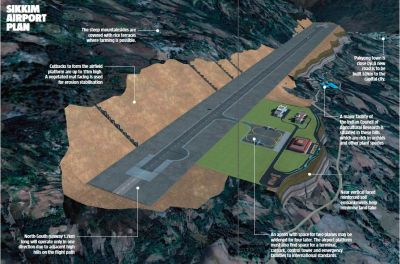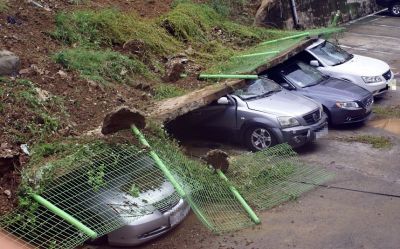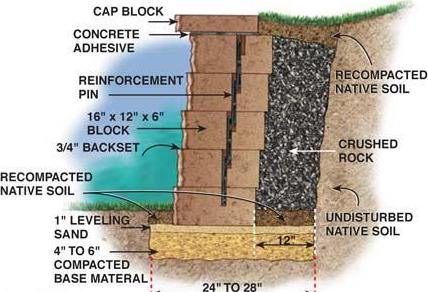Modern techniques and materials have allowed great advancements in building design and construction, taking us from mud huts to sky scrapers. Dwellings aside however, there is another unsung hero of the construction world that has also benefited from these advancements: The retaining wall. Retaining walls are used to restrain soil to an unnatural slope. That is, the wall reshapes and holds the soil so that the ground below or above the wall can be repurposed in such a way to make it useful, safe and more attractive. Think terraced farming or embankment support on a highway overpass. Similarly, a basement wall can be thought of as a retaining wall. However, houses support the basement wall from the top and sides. A typical retaining wall is just that: One wall. Since this one wall is doing all the work, it is very important to design a structurally sound, weight and pressure resistant wall appropriate to its environment and expected load. No two retaining walls are the same. They are customized to the unique requirements of a site.
Trivia fact: Sited for completion at the end of 2014, Pakyong airport in India is being built at an altitude of 4,700 ft., which will be one of the five highest airports in India. The reinforcement wall on the project is 80 meters high, which is one of the tallest reinforcement walls in the world. That?s about 262 feet. To put that into comparison, the Great Wall of China is about 8 m high at its highest point (and the Great Wall of China is not a retaining wall; unless you count retaining invading Huns).
Retaining walls can be found everywhere and often do not get the respect that they deserve. A retaining wall may appear to be a simple structure. Designing and constructing one can appear to be a simple process. Far from it, retaining walls are complex engineered structures that require a great deal of design and attention to proper construction. They are much more than just blocks placed in front of dirt. If they are not designed or built adequately, not only is the wall itself in danger of failing, but the property above and/or below the wall as well as the lives that rely on the wall are in harm?s way as well.
There are various ways to build a retaining wall. However, what all walls have in common is a proper design and installation to counteract the tendency of the retained material to move downslope due to gravity. Earth pressures will push the wall forward or overturn it if not properly addressed. Dirt can be heavy. Wet dirt can be extremely heavy. Enter one of the two most common reasons for retaining wall failure: Water.
One inch of rain on a square foot of land weighs about 5.2 pounds. To be clear, that is an additional 5.2 pounds added to the soil already in place. With enough saturation and a large enough volume of soil, water can easily add additional TONS of weight that a retaining wall is challenged to hold back. It should come as no surprise that most retaining wall failures occur after a rainstorm. A mudslide is a good demonstration of the power and destructive ability of water and earth; it visually unveils the energy that is often hidden behind a retaining wall. Having an appropriate drainage system for the wall is paramount to mitigate or remove the additional weight and pressure that water brings with it.
The second most common reason a retaining wall may fail has nothing to do with Mother Nature but rather human nature. It is a breakdown in the communication and collaboration between multiple disciplines required to build it. A small flower bed retaining wall built by a homeowner may not require extensive planning and resources. However, the larger the project, the more specialized talent is brought to bear. For example, a civil engineer may decide a retaining wall is needed to hold back the earth on the side of a highway cut through the mountains. A geotechnical engineer may evaluate the soil or rock that will be below and behind the wall to determine the technical needs for a design. Using that information, a structural engineer may complete a detailed design, while the owner and/or architect decide how the visible parts of the wall should appear. Furthermore, a supplier provides materials, a surveyor may help decide where exactly to build it, and the general contractor hires a landscape contractor, who may then hire other specialty contractors to help construct it. The entire process is ripe for miscommunications and mistakes, any one of which can mean catastrophe.

The next time you drive by a retaining wall, think about what materials and pressures it is holding back and what the designers, engineers and construction workers must have done to put it there. Respect the wall.
CED’s civil engineering group can help evaluate the technical aspects of retaining wall failures as well as sort through the responsibilities of the multiple parties often involved in the design and construction of them.
Submit a case or claim online.
Contact a CED Engineer in you region.






